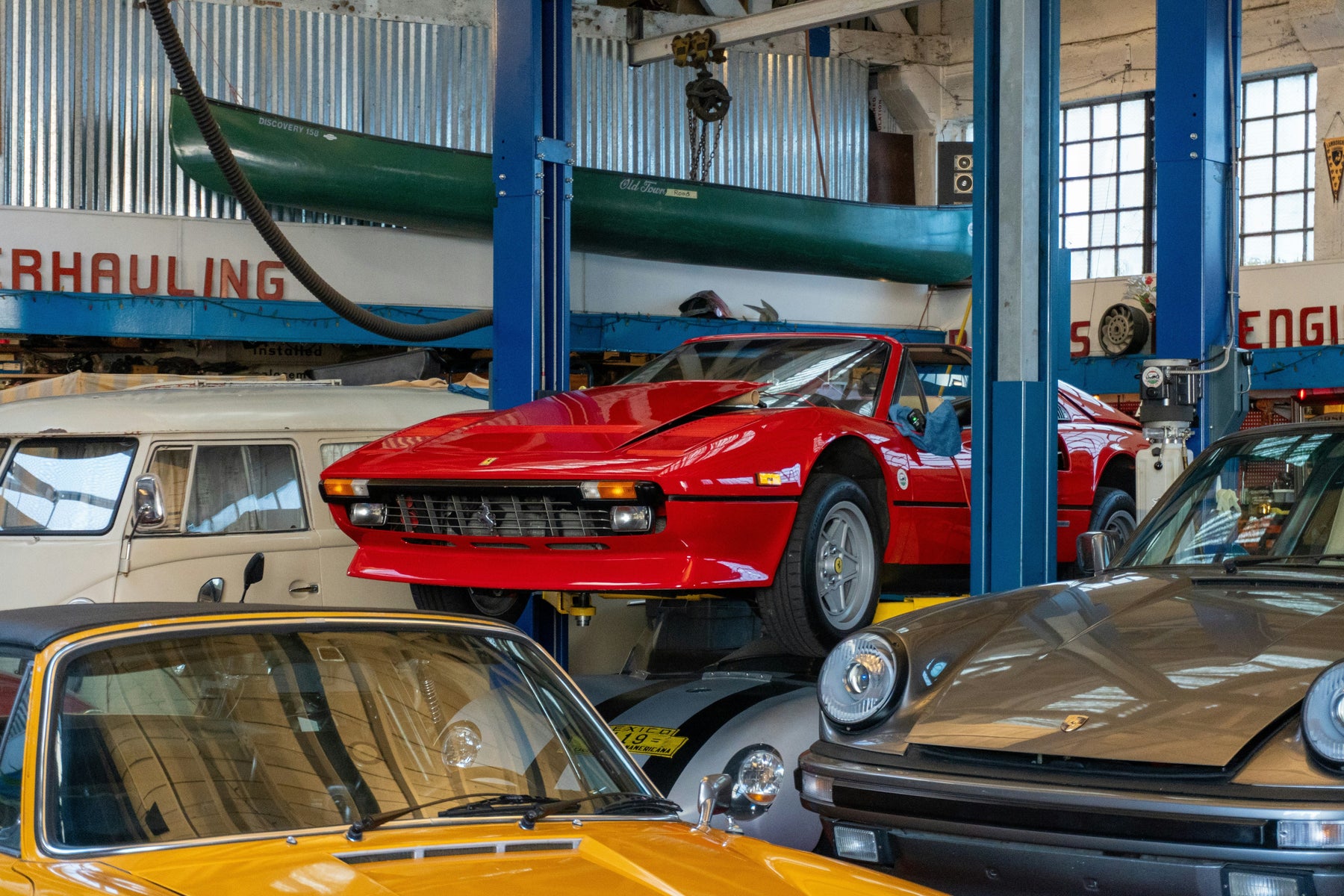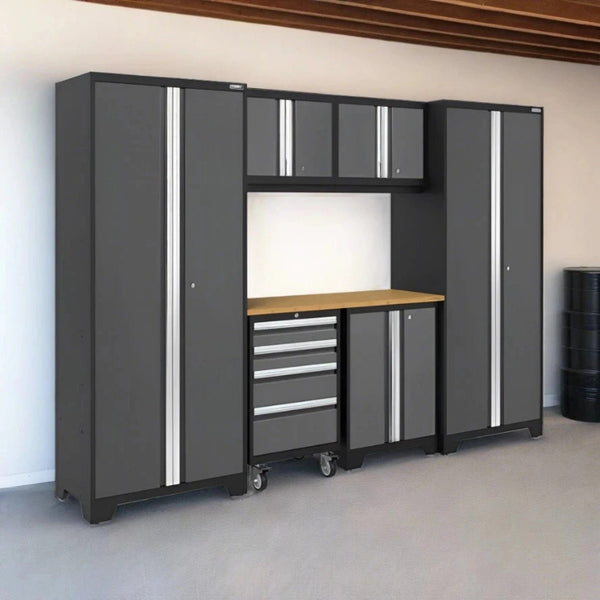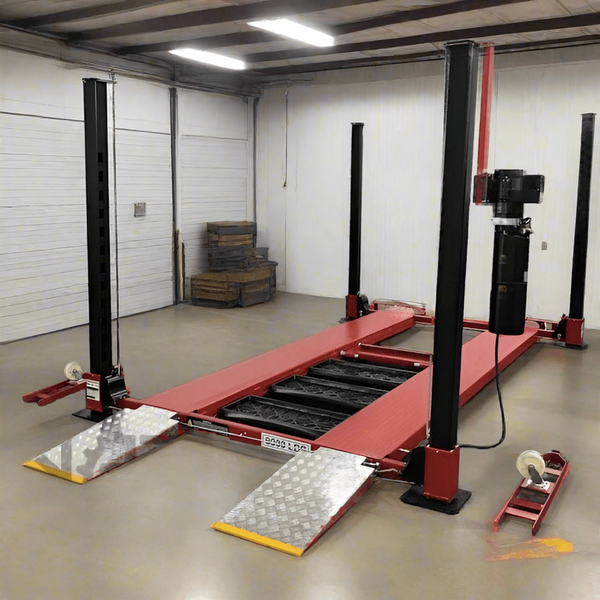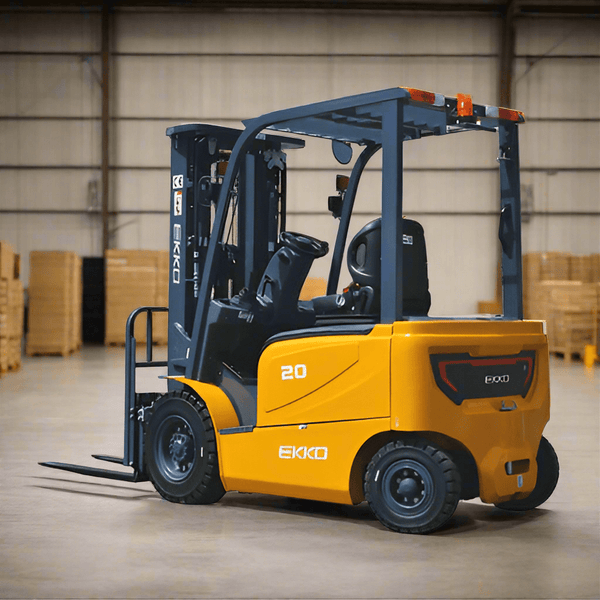
2-Post Lift vs Scissor Lift
Whether you’re buying your first car lift or upgrading your garage, you’ll have no shortage of options at your fingertips here at My Garage Supplies - your trusted choice for car lifts from the best brands in the industry.
Two styles we see compared all the time are the 2-post lift vs scissor lift - and we’re here to help you choose the right option based on your garage size and concrete depth/strength, service requirements, and storage needs.
Most of our customers prefer the 2 post car lift because you get full undercarriage access. They’re the most popular choice for commercial shops. But, they have high ceilings and concrete requirements.
A car scissor lift, on the other hand, is the smarter choice for low-ceiling garages and light-duty service. They’re often portable, but this comes at the cost of stability. You won’t get the same access to the underbody of the vehicle either.
You can get in touch with our customer support team for one-on-one assistance choosing between a 2-post vs scissor lift. We stock both styles from industry-leading manufacturers and are passionate about helping our customers pick the right equipment.
Learn more below or reach out now for a personalized recommendation!
|
Feature |
2-Post Lift |
Scissor Lift |
|
Best For |
Full mechanical access, frequent service, professional repair |
Brake jobs, detailing, tire work, compact home garages |
|
Undercarriage Access |
Complete (wheels, drivetrain, suspension fully accessible) |
Partial (center obstructed by lift platform) |
|
Ceiling Height Needed |
10-12 ft or more |
Works in low ceilings (standard residential garages) |
|
Concrete Requirements |
4-6" thick at 3,000 PSI minimum |
Lower slab demands; some models are portable |
|
Power Requirements |
Typically 220V |
Often 110V (household outlet) |
|
Portability |
Fixed install, not portable |
Many models are portable or stowable |
|
Installation Complexity |
More involved; requires anchoring and electrical work |
Simple install; minimal anchoring or setup required |
|
Storage Use |
Not ideal for long-term vehicle storage |
Can be used for short-term storage if rated appropriately |
Overview of 2-Post Lifts
These are the most widely used in professional garages, but they work well in home garages as well in some cases. They operate by securing the vehicle at designated lifting points on the frame using adjustable arms that extend from two upright posts - as the name suggests.
The vehicle is fully suspended above the ground, leaving the wheels, undercarriage, suspension, and drivetrain completely accessible. So, 2-post lifts are perfect for brake jobs, exhaust work, transmission replacement, and general inspections.
That access is the biggest advantage this style brings to the table. It's easy to rotate tires, drop the transmission, or reach hard-to-access components under the car because the wheels hang free.
It’s also space-efficient, unlike a 4-post list, which forces you to work around platforms. You’ll never deal with issues maneuvering under the vehicle. Read our comparison of the 2-post lift vs 4-post lift for more insights.
But, 2-post lifts do have their drawbacks, as is the case with any type of vehicle lift. Most notably, these lifts require more from your garage - both in terms of available space AND concrete depth/strength.
Most models need a ceiling height of at least 10 feet, and your concrete slab must be at least 4”-6” thick, rated at 3,000 PSI or more. These 2-post car lift space requirements may not align with your garage as it stands now.
Overview of Scissor Lifts
Scissor lifts use a compact, platform-based design that raises the vehicle by lifting arms located beneath the frame or pinch welds. The lifting action comes from a set of crossed support arms that expand vertically in a scissors-like motion, which is where the name comes from.
Scissor lifts don’t raise the vehicle from the side like 2-post lifts do. Instead, they lift it evenly from underneath. In this sense, they’re great for low-clearance garages with little vertical room.
There’s also the portability factor. Many models can be rolled away or stored flat when not in use, which is great for home users who don’t want to dedicate permanent floor space to a lift.
These lifts are much simpler from an installation perspective as well. They require less demanding concrete or electrical setups. Many operate on a standard 110V outlet and don’t need heavy anchoring.
They are best suited for tire service, brake jobs, and detailing, though, since you won’t get full undercarriage access. The lift points are usually located along the sides of the vehicle, which means the center remains blocked by the lift itself. Transmission or exhaust work isn’t practical.
That said, these are still a viable option for hobbyists, detailers, or anyone who needs occasional access to the underside of a car. So, is this the right choice for you between a 2-post lift vs scissor lift?
2-Post vs Scissor Lift: Which Style is Right For Your Garage?
We get asked all the time, is a car scissor lift better than 2-post lift? Or, is it the other way around? At the end of the day, one isn’t inherently superior to the other. It’s just a matter of finding the right fit for your garage.
Choosing between a 2-post vs scissor lift comes down to your available space, the type of work you anticipate doing, and a few other factors, which we’ll help you weigh below.
Garage Size and Ceiling Height
The biggest difference between a 2-post lift vs scissor lift comes down to how much space they take up in a garage. The scissor lift is much more adaptable to low-clearance spaces, often requiring less than 6 feet of vertical lift height and fitting easily into standard residential garages.
On the other hand, 2-post lifts usually need a ceiling height of at least 10 to 12 feet to accommodate full lift height and post clearance. That isn’t a problem in commercial shops or detached garages with tall ceilings, but it rules these out for many residential garages.
Other Installation Requirements
Aside from garage space, the concrete in which you plan on anchoring your lift to influences your choice between a 2-post lift vs scissor lift. Remember, 2-post lifts call for 4-6 inches of concrete rated at 3,000 PSI - they also need a dedicated 220v circuit most of the time.
In contrast, scissor lifts only need 110v power and minimal anchoring. Some models are actually portable or freestanding. They’re way easier to install, especially in garages with unknown or marginal concrete conditions.
Undercarriage Access and Service Versatility
It’s clear that 2-post lifts come with a lot more considerations. But, they are really the only choice for some garages because of how much access they provide to the undercarriage.
These lift the vehicle by the frame, leaving the wheels and underbody completely exposed so you can easily service the drivetrain, suspension, or exhaust.
Scissor lifts limit access to the center of the vehicle, which can restrict repairs like transmission service or fuel system work. They're fine for tire rotations, brake jobs, and detailing, but not for complete mechanical overhauls.
Safety and Stability
Be clear, both lifts can be perfectly safe when you invest in a trusted brand like those we carry at My Garage Supplies - and you install them correctly. However, they differ in design.
2-post lifts are anchored directly to the slab and rely on column alignment and locking mechanisms. They must be leveled and torqued to spec.
Since scissor lifts have a lower center of gravity and fewer moving parts, operation is much simpler - and there’s a lot less risk in low-clearance environments. Just know cheaper scissor lifts without robust safety locks can present issues over time, especially under load.
Storage and Portability
Some lifts support not only vehicle maintenance but vehicle storage. A 2-post lift does not, though. It suspends the car by the frame, and leaving the suspension unloaded for long periods can cause unnecessary wear and tear.
Scissor lifts aren’t necessarily meant for storage either, but they are a better choice for short-term parking applications or routine work where vehicles are lifted briefly.
As far as portability goes, though, scissor lifts have an obvious edge in that many can be moved, repositioned, or stored when not in use. 2-post lifts, by contrast, are permanent installations and take up more floor space.
So, is a Car Scissor Lift Better Than a 2-Post Lift - or is it the Other Way Around?
So is a car scissor lift better than a 2-post lift? Once again, choosing between a 2-post vs scissor lift is a very individualized decision. Neither is better across the board, they serve different needs.
2-post lifts are built for full mechanical access and daily repair work. Scissor lifts are ideal for low-ceiling garages, light-duty tasks, or users who need portability. Your best option depends on what you’re lifting, how often, and where.
But no matter what your ideal lift looks like, your search for the best residential garage car lifts or commercial automotive repair lifts ends here at My Garage Supplies.
My Garage Supplies is Your Trusted Choice for ANY Type of Vehicle Lift!
We stock exclusively garage-grade equipment - no gimmicks, no cut-rate knockoffs. All our equipment is sourced from industry-leading brands like Atlas, AMGO, Triumph, Katool, Tuxedo, and iDEAL, so you can shop with confidence knowing you’re getting a safe, dependable lift.
Our team understands the technical details that matter, from concrete specs to power requirements, and we offer personalized support before and after your purchase.
That means you can reach out now for personalized support choosing between a 2-post lift vs scissor lift - or even a single-post lift or 4-post lift. We’ve got it all, whether you’re building out a home garage or outfitting a full commercial bay. Take the next step now!
Bringing Our 2-Post vs Scissor Lift Comparison to a Close
Hopefully this scissor lift vs 2-post lift comparison has left you feeling clear about the benefits and considerations of each style, and more specifically, which best suits your needs. Each lift has a clear place depending on your workspace, vehicle types, and day-to-day workflow.
Our blog has additional resources on topics like choosing between a symmetric vs asymmetric lift, if you do end up going the 2-post route. This is another important consideration.
Otherwise, the only thing left to do now that you understand all the nuances between a 2-post lift vs scissor lift is head over to My Garage Supplies and narrow it down to a brand and model.
Or better yet, get in touch with our customer service team for one-on-one guidance. Let’s get your garage set up for what you actually need!



